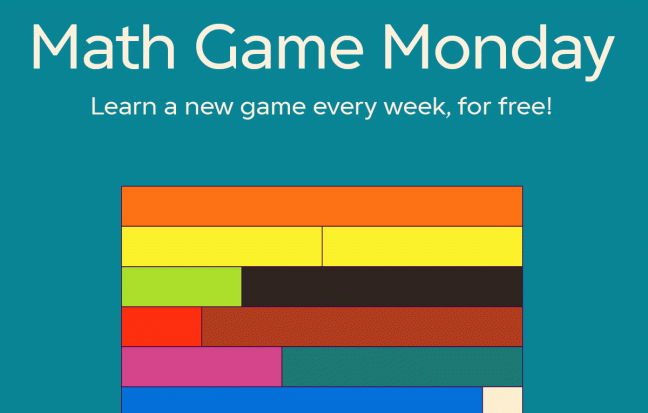Many parents remember struggling to learn math. We hope to provide a better experience for our children.
And one of the best ways for children to enjoy learning is through hands-on play.
This game features the Cuisenaire rods, but you may play with any math manipulative based on length: Montessori bead chains, Mortensen or Math-U-See blocks, etc. Or draw pictures on graph paper.
The Partitions Game
Math Concepts: partitions, part/whole, addition, multiplication, algebra.
Players: two or more.
Equipment: Cuisenaire rods (or other math manipulatives) or graph paper, pencil and paper (optional).
Set-Up
Dump the rods on the table, where all players can reach them. Clear a space in the middle for building your game.
Players must agree in advance whether the same rods in a different order will count as a new partition.
How to Play
The first player chooses any rod (yellow or longer) and sets it in the middle of the table. Or if using graph paper, the first player outlines a row of squares (five or longer).
The second player adds a new row of two or more rods that make the same length. Or draws a new same-length row of squares, split into two or more sections.
Players continue to add rows in turn. Each row must be different from all those already played.
Whoever plays the last new partition, leaving the other players stumped, wins that round and gets to choose a new starting rod.

Variation
Depending on the age of your child, you may want to keep “score” by writing an expression to represent each row. You may use numbers, but I like to give children a head-start on understanding algebra by using the color names or initials.
For example, you might write the game above as:
- orange = 2 × yellow = green + black, etc.
- o = 2y = g + k, etc.
[We use k for black, t for tan (brown), and b for blue.] - 10 = 2 × 5 = 3 + 7, etc.
[Assuming you treat the white rod as one unit.]
Writing everything out does not increase the mathematical content of the game. The written symbols are not mathematics, any more than the lines and dots written on a staff are music. Music only happens when we play the notes, just as math only happens when we think the ideas.
Your children will be thinking like a mathematician, even if they write nothing down. But writing helps them grow comfortable with math notation (the way we write math on paper), which will be useful when they want to communicate their own mathematical thoughts.
* * *
 This game is an excerpt from Let’s Play Math: How Families Can Learn Math Together and Enjoy It. Discover more of my playful math books at my publisher’s Playful Math Store.
This game is an excerpt from Let’s Play Math: How Families Can Learn Math Together and Enjoy It. Discover more of my playful math books at my publisher’s Playful Math Store.
Special Offer: Would you like to access a growing archive of Math Monday games and other activity ideas as convenient printable pdf downloads, ready to print and play with your kids? Join me on Patreon for mathy inspiration, tips, printable activities, and more.
“Math Game Monday: The Partitions Game” copyright © 2024 by Denise Gaskins.
